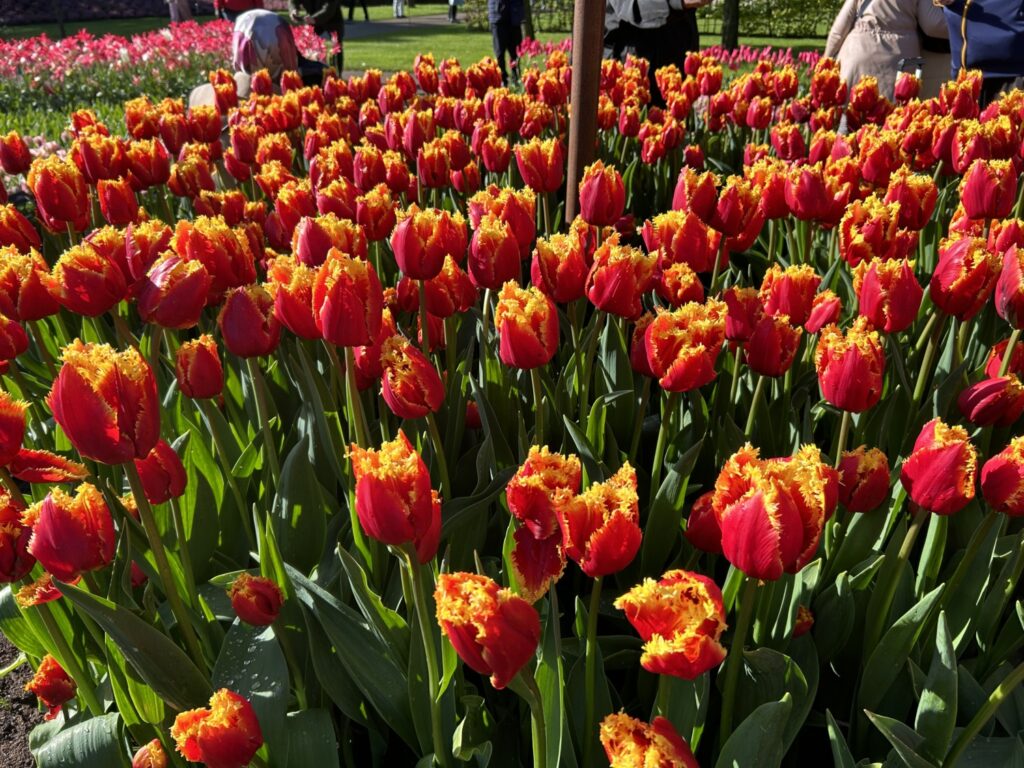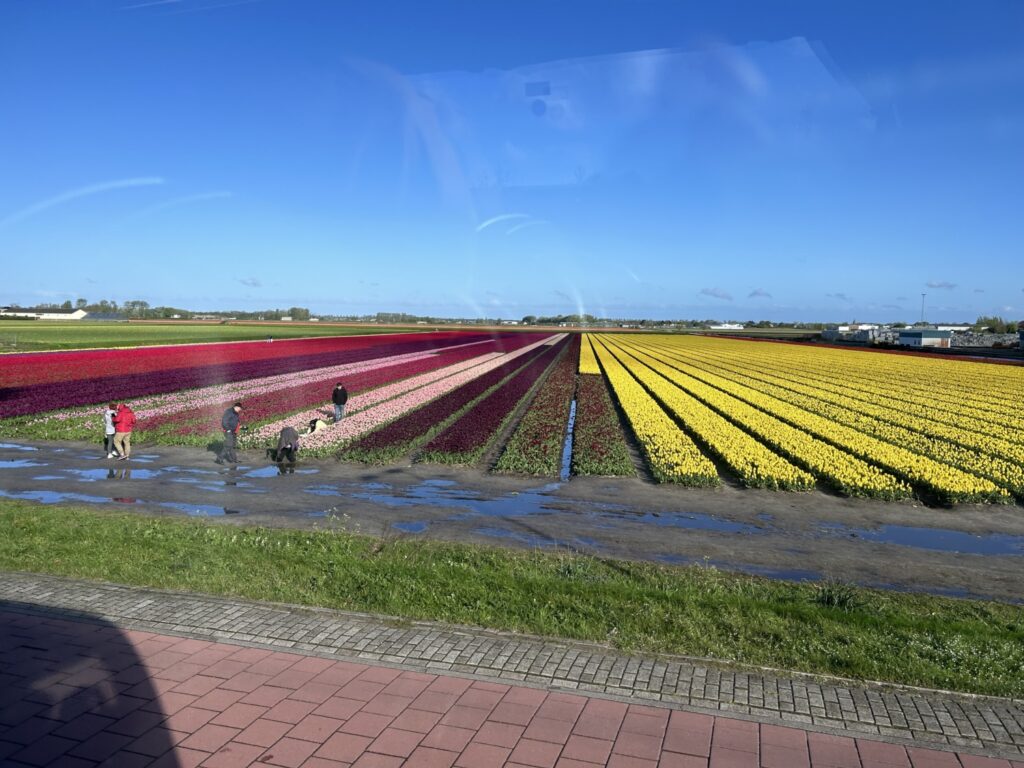One of the best reasons to go to Europe in April is to visit Keukenhof Gardens in Lisse, Netherlands. Keukenhof Gardens has the best display of tulips in Europe and it is only open from March 21 to May 12. During those eight weeks, the show is spectacular as tulips, daffodils, and other spring flowers dazzle the thousands of visitors.
We took a shore excursion from our port in Rotterdam to Keukenhof Gardens. It took about an hour to get there on the bus, and our guide said they were expecting 80,000 visitors on that particular Sunday. It was a beautiful, sunny day, even though it was cold (45) and windy.
Our guide kept up a running commentary on the way to the gardens. He was an older man with four daughters, three of whom still lived at home even though they were 31, 28, and 26. Skip told us that he told his daughters to find a boyfriend with a house because it was difficult to find housing in the Netherlands. He told them they could always fall in love with the man later, but it was much harder to find a man with a house than to fall in love. Very pragmatic and Dutch. I’m not sure if any of his daughters will take him up on it though.
When we arrived at Keukenhof Gardens we unloaded amid all the busses and other tourists coming for the show. And the flowers did not disappoint. In fact, after several hours, we definitely had tulip overload. Everyone starts off taking lots of pictures, then you realize the futility of capturing all that beauty. After a while I tried to just admire and contemplate the flowers instead of trying to take pictures of each kind.
One very interesting area of the park was the history of the tulip. In this garden they had a bust of Carolus Clusius, the father of the modern tulip. They also had some heritage tulip bulbs, most of which were not flowering. Tulips used to be smaller with thinner petals. Over time they have been bred and hybridized to be the large, showy flowers that they are today. There are about 75 species of tulips, and these are divided among four subgenera.
In horticulture, tulips are divided into fifteen groups (Divisions) mostly based on flower morphology and plant size. I am listing them here because we saw all of them at Keukenhof. This list is taken from the Wikipedia article on tulips.
- Div. 1: Single early – with cup-shaped single flowers, no larger than 8 cm (3 inches) across. They bloom early to mid-season. Growing 15 to 45 cm (6 to 18 inches) tall.
- Div. 2: Double early – with fully double flowers, bowl shaped to 8 cm (3 inches) across. Plants typically grow from 30–40 cm (12–16 inches) tall.
- Div. 3: Triumph – single, cup shaped flowers up to 6 cm (2.5 inches) wide. Plants grow 35–60 cm (14–24 inches) tall and bloom mid to late season.
- Div. 4: Darwin hybrid – single flowers are ovoid in shape and up to 6 cm (2.5 inches) wide. Plants grow 50–70 cm (20–28 inches) tall and bloom mid to late season. This group should not be confused with older Darwin tulips, which belong in the Single Late Group below.
- Div. 5: Single late – cup or goblet-shaped flowers up to 8 cm (3 inches) wide, some plants produce multi-flowering stems. Plants grow 45–75 cm (18–30 inches) tall and bloom late season.
- Div. 6: Lily-flowered – the flowers possess a distinct narrow ‘waist’ with pointed and reflexed petals. Previously included with the old Darwins, only became a group in their own right in 1958.
- Div. 7: Fringed (Crispa) – cup or goblet-shaped blossoms edged with spiked or crystal-like fringes, sometimes called “tulips for touch” because of the temptation to “test” the fringes to see if they are real or made of glass. Perennials with a tendency to naturalize in woodland areas, growing 45–65 cm (18–26 inches) tall and blooming in late season.
- Div. 8: Viridiflora
- Div. 9: Rembrandt
- Div. 10: Parrot
- Div. 11: Double late – Large, heavy blooms. They range from 46 to 56 cm (18 to 22 inches) tall.
- Div. 12: Kaufmanniana – Waterlily tulip. Medium-large creamy yellow flowers marked red on the outside and yellow at the centre. Stems 15 cm (6 inches) tall.
- Div. 13: Fosteriana (Emperor)
- Div. 14: Greigii – Scarlet flowers 15 cm (6 inches) across, on 15-centimetre (6 in) stems. Foliage mottled with brown.
- Div. 15: Species or Botanical – The terms “species tulips” and “botanical tulips” refer to wild species in contrast to hybridised varieties. As a group they have been described as being less ostentatious but more reliably vigorous as they age.
- Div. 16: Multiflowering – not an official division, these tulips belong in the first 15 divisions but are often listed separately because they have multiple blooms per bulb.
Keukenhof Gardens is divided into different sections all connected by miles of tulip beds. There is a section that has a windmill and an observation deck. You can look out and see the tulip fields all in bloom surrounding the gardens. Another section had a caliope that was really fun to listen to and watch. This section also had a big fountain and lots of families were sitting around it enjoying the music and the beautiful day.
Tom and I managed to see most of the gardens during the two hours we were there. We tried to check out the gift shop but there were too many people to move inside it. They were selling tulip bulbs for exhorbitant prices. I think I will keep buying my bulbs from Breck’s: a real Dutch company that ships the same bulbs to me for much less.

We found a lot of favorite tulips. We both enjoy the ones that have more than one color and aren’t shredded on the ends. Keukenhof Gardens has seven million flowers on any given day during its short season. Plenty for everyone to enjoy and appreciate. If you are ever going to the Netherlands, you want to be sure to get to Keukenhof.













